Exploring Finch Bird Toys for Avian Enrichment
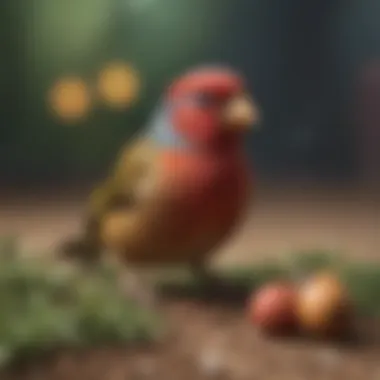
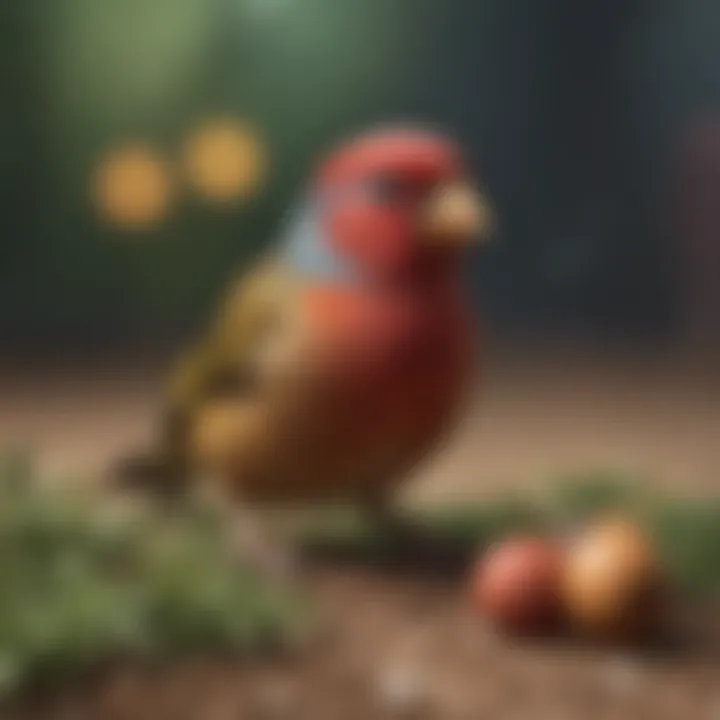
Intro
Finch birds are well-known for their vibrant colors and melodious songs. However, many bird owners overlook a critical aspect of their well-being—enrichment through toys. This guide will examine the essential role of toys in promoting mental stimulation and physical activity for finches.
In this article, we will explore the various types of finch bird toys available on the market, along with practical tips for selecting the right ones for your feathered friends. The goal is to provide bird owners with the knowledge needed to enhance their birds' lives, ensuring a joyful and fulfilling experience for both the pet and the owner.
Understanding the environmental needs of finch birds significantly contributes to their overall wellness. Enrichment isn't just about visual appeal; it's an integral facet of their care that fosters health, happiness, and longevity. Let's dive into the first section of this comprehensive guide.
Understanding Finch Behavior
Understanding the behavior of finches is crucial in providing an appropriate environment for these vibrant birds. Their natural habits and social structures have a significant impact on their overall well-being. Knowing what influences their actions helps caregivers select the right toys that enhance their quality of life. The finch's instinctual tendencies and their need for social interaction are essential factors to consider when designing an engaging habitat. This understanding not only supports their mental stimulation but also encourages healthy physical activity.
Natural Habits and Socialization
Finches are highly social creatures. In the wild, they thrive in large flocks, which contributes to their survival and well-being. Their natural behavior includes vocalizations, social interactions, and playful activities among their peers. Socialization serves as a means of communication and bonding, vital for their emotional health.
In captivity, it is crucial to mimic these social conditions. Having multiple finches can promote natural behaviors, such as grooming and play. If owning just one, ensure to dedicate time each day for interaction. Enrichment through toys becomes essential if social companions are limited. Toys that mimic social interaction, or even ones with sounds, can provide stimuli that encourage exploration and engagement.
Cognitive Needs in Captivity
Cognitive stimulation is often overlooked in captive finches. In their natural habitat, these birds engage in various activities that challenge their minds, such as foraging for food. Captivity limits these opportunities, which can lead to boredom and stress. Addressing their cognitive needs can significantly improve their overall well-being.
Engaging toys like foraging puzzles not only occupy their time but also encourage problem-solving skills. These activities are important as they help finches exhibit natural behaviors that keep them mentally sharp. Understanding the type of enrichment necessary helps caregivers foster a stimulating environment, ensuring their finches lead a happy and fulfilling life.
"A well-enriched environment leads to happier and healthier finches."
By recognizing the innate behaviors of finches and adapting their environment accordingly, you can greatly enhance their quality of life. This foundation of understanding is necessary when moving forward to the importance of enrichment that toys provide for these lively birds.
Importance of Enrichment
In the realm of avian care, the importance of enrichment cannot be overstated. Enrichment encompasses a variety of activities and stimuli that are essential for the physical and mental health of finches. It goes far beyond mere entertainment. It is a foundation for promoting health, wellbeing, and social behaviors in these small but vibrant birds. The right toys foster curiosity, encourage exploration, and support a sense of security within the bird’s environment.
Engaging finches with enriching toys can lead to profound benefits. Mental stimulation is paramount. Birds are naturally inquisitive; they thrive when they have opportunities to engage their minds. Toys that challenge cognitive skills, mimic foraging behavior, or require problem-solving can greatly enhance their daily lives. This engagement not only fosters a sense of accomplishment but also reduces the likelihood of behavioral issues stemming from boredom or depression.
Furthermore, enrichment plays a significant role in reducing stress and boredom. For finches, an environment that lacks stimulation can lead to detrimental behaviors, such as excessive vocalization, feather plucking, or aggression towards other birds. By providing a varied selection of toys, owners can mitigate these risks. This proactive approach ensures that finches express their natural behaviors, ultimately leading to a more peaceful and harmonious living situation.
Mental Stimulation
Mental stimulation is crucial for the overall health of finches. These birds possess a high degree of intelligence and curiosity, meaning they require activities that mentally challenge them. Toys designed for problem-solving, such as puzzles or foraging toys, can significantly stimulate a finch's intellect.
When a finch interacts with such toys, it mimics behaviors seen in the wild, where they need to search for food. This kind of play not only enriches their daily routine but also keeps their cognitive abilities sharp. Implementing a rotation of different types of toys ensures that the finch remains engaged and stimulated.
The benefits of mental stimulation are clear:
- Enhanced problem-solving abilities
- Improved mood and decreased lethargy
- Stronger cognitive processing
Reducing Boredom and Stress
Boredom in finches can lead to a range of problems, including stress-related behaviors, aggression, and anxiety. A lack of stimulating activities can cause these birds to become restless, leading to discontentment. Hence, reducing boredom is closely linked to enriching their environment with appropriate toys.
Providing a variety of toys helps to keep finches occupied and mentally engaged. Toys that encourage movement, such as swings or climbing structures, can significantly reduce stress levels. These activities allow finches to express their natural instincts in a healthy way, which contributes to their overall wellbeing.
Consider the following strategies to effectively reduce boredom and stress:
- Incorporate a diverse range of toys
- Rotate toys regularly to maintain interest
- Observe your finch’s preferences for certain types of play
Types of Finch Bird Toys
Understanding the types of bird toys available for finches is essential for creating an engaging and stimulating environment for these intelligent creatures. Finch birds require toys that not only entertain them but also promote their physical health and mental well-being. Different types of toys serve various purposes, contributing to the overall enrichment of their lives. In this section, we will explore the primary categories of finch toys, focusing on their unique features and benefits.
Perches and Platforms
Perches and platforms are fundamental components in any finch's habitat. They provide essential resting spots and encourage natural behaviors like climbing and exploring. Having varying heights and textures in perches can stimulate a finch's curiosity.
- Benefits: Perches help in maintaining foot health and allowing exercise. They can also be positioned near food and water to facilitate easy access for the birds.
- Considerations: When choosing perches, it is important to select different materials like wood, plastic, or rope to ensure variety. Additionally, the diameter of the perch should be appropriate for the size of the finch's feet.
Perches come in various designs, including natural branches or commercial products that mimic them. These can support a finch’s inclination to chew, which is a natural part of their behavior.
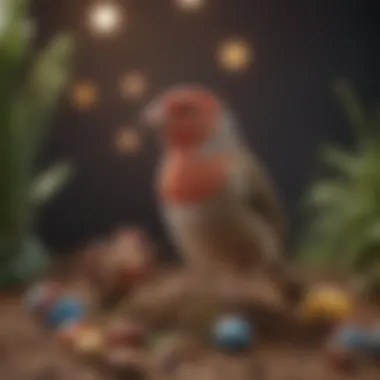

Swing Sets and Hanging Toys
Swing sets and hanging toys add a three-dimensional element to the cage environment. These toys encourage active play and provide finches with opportunities for exercise and social interaction.
- Benefits: Swinging motions stimulate a finch's motor skills and coordination. The act of swinging can bring joy and excitement, as these activities align closely with their natural instincts.
- Considerations: Ensure that hanging toys are securely fastened to avoid accidents. Also, the materials used should be safe and non-toxic. Check for any sharp edges that might harm the birds while they play.
Swing sets can be simple, consisting of a perch attached to two points, or more elaborate with additional hanging elements to challenge the finch's dexterity.
Foraging Toys
Foraging toys are essential for mental stimulation, mimicking the natural behavior of seeking food in the wild. These toys challenge finches to think and solve problems to access their food.
- Benefits: Foraging challenges help reduce boredom and prevent destructive behaviors. They engage a bird's natural instincts by making them work for their treats, which can be mentally rewarding.
- Considerations: When selecting foraging toys, choose those that are suitable for the specific finch species. Look for toys that can be filled with seeds, fruits, or treats to keep your finch intrigued and engaged.
Types of foraging toys can include puzzle feeders or toys that dispense treats only when manipulated correctly, fostering exploration and cognitive growth.
Chewing and Destructive Toys
Chewing and destructive toys cater to a finch's natural urge to gnaw on materials. These toys are important for maintaining beak health and providing a satisfying outlet for their chewing tendencies.
- Benefits: These toys help in preventing boredom-related issues and give them a constructive way to expend energy. Regular chewing can also aid in keeping their beaks trimmed and healthy.
- Considerations: Ensure that the materials used are safe and appropriate for finches. Natural woods and untreated products are usually the best options. Monitor the toys regularly for wear and tear to prevent ingestion of small pieces that could pose a choking hazard.
Chewing toys can take various forms, including wooden blocks, shredded paper, or even natural fibers that are safe for them to tear apart.
Incorporating a variety of toys into a finch's cage is crucial. Each type contributes uniquely to their enrichment, vibrancy, and overall well-being.
Selecting the Right Toys for Your Finch
Selecting toys for your finch is essential for ensuring their quality of life. Toys serve multiple purposes, promoting not only mental and physical stimulation but also mimicking interactions that finches would experience in the wild. Lack of appropriate toys may lead to boredom and stress, ultimately affecting the finch’s health and behavior.
When choosing toys, it is crucial to keep in mind your finch's specific needs and preferences. The finch species you own will influence the type of toys that are suitable. Moreover, safety should always be a priority in toy selection. In this next part, we will explore how to select the right toys by considering different finch species, the importance of materials used, and ensuring correct sizes and accessibility for your birds.
Considering Finch Species
Different species of finches have unique habits and preferences that should guide your toy selection. For instance, society finches tend to enjoy social play and may benefit from toys that encourage interaction, such as swings or mirrored surfaces. On the other hand, seed finches might prefer foraging toys that allow them to engage in natural scavenging behaviors.
It’s important to research the specific needs of your f inch species. Some species are more energetic and require toys that can stand up to vigorous play. Others may prefer quieter interactions, such as simple perches or lightweight hanging toys.
Safety and Materials
In any situation involving pets, the safety of materials used in toys is paramount. Opt for non-toxic materials. Wood, natural fibers, and high-quality plastics are good choices. Avoid toys painted with harmful chemicals or made from soft plastics that can be easily chewed and swallowed.
When selecting toys, here are some points to consider:
- Non-Toxic Finish: Ensure any wood has a safe sealant.
- Durability: Choose sturdy toys for more active finches.
- Natural Options: Natural materials tend to be safer and more appealing.
Monitoring the wear and tear on toys is also crucial. Regularly inspect them for splinters or sharp edges that could pose a risk to your finch.
Size and Accessibility
Size plays a critical role in toy selection as well. Toys that are too large can be inaccessible for smaller finches. Conversely, toys that are too small may not provide enough stimulation and could be a choking hazard. Aim for toys that fit within the confines of their cage while allowing safe freedom of movement.
Accessibility is just as important. Toys should be easy for finches to reach and use without excessive effort. Hanging toys should be positioned where finches can gently swing and perch. Perches should be at different heights to promote climbing and exploration.
"Choosing the right toys based on your finch's species, safety, and size can significantly enhance their playtime and overall well-being."
Ensuring that you comply with these criteria will help in creating an enriching environment. Such thoughtfulness in choice enriches the daily lives of these delightful birds.
Introducing New Toys
Introducing new toys can be a pivotal moment for finch owners. Toys serve not just as entertainment, but as key elements in promoting the health and happiness of these birds. When new toys are introduced thoughtfully, they can stimulate a finch's desire to explore and engage with its environment. This engagement not only helps reduce boredom but also fosters a sense of curiosity and playfulness that are vital for their overall well-being. It is crucial to consider their individual personalities. Not every finch will respond the same way to new items, so tailoring the introduction process is essential.
Gradual Intro Process
The gradual introduction of new toys to finches can be beneficial. Birds may be wary of changes in their environment, and an abrupt introduction could lead to stress. Start by placing the new toy nearby where the finch can see it without feeling threatened. Allow the bird to inspect the item from a distance. After some time, you can move the toy closer to their perch or play area. If the finch shows interest, you can more confidently add the toy to their space.
Here are the steps for an effective gradual introduction:
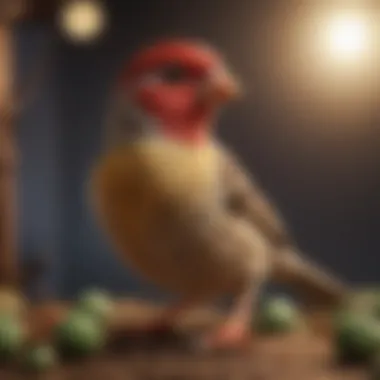
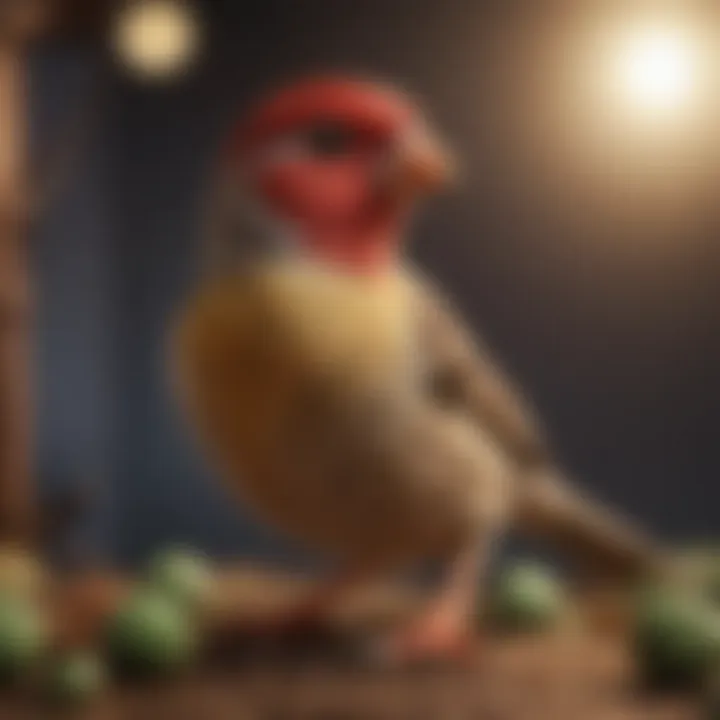
- Observe Behavior: Watch how the finch reacts to the new toy. Curiosity is a good sign.
- Remove Older Toys: Sometimes, removing toys that are less engaging can encourage interest in new ones.
- Use Treats: Place some treats near the toy to attract your finch's attention. This can create a positive association.
- Monitor Interaction: Keep an eye on how the finch interacts with the toy during the initial days.
Observing Finch Interaction
After introducing new toys, observing how your finch interacts with them is key. Each bird has unique preferences. Some may take to new toys right away, while others need more time to explore. Watching their behavior allows you to gain insights into what types of toys they enjoy most.
Key behaviors to watch include:
- Exploration: Is the bird pecking, climbing, or exploring the toy?
- Playfulness: Does it engage in swinging or using the toy frequently?
- Avoidance: If the finch seems to avoid the toy, it may not appeal to them or could be intimidating.
By systematically observing these behaviors, you can refine your toy selection moving forward. If certain types of toys consistently draw interest, consider acquiring more similar items.
"Toys are not a luxury for finches; they are a necessity that fosters play and stimulation."
Understanding your finch’s reaction to new toys not only promotes a happier bird but also builds the bond between owner and pet. A well-structured approach in introducing new toys fosters trust and a sense of security in the finch, ultimately enriching its quality of life.
Benefits of Interactive Play
Interactive play is essential for the mental and physical health of finches. When finch owners engage their birds with toys, it results in a more fulfilling living environment. It enhances interaction between the owner and the bird, which can strengthen their bond. Playing with toys is not just entertainment for finches; it fulfills their need for stimulation. When finches play, they show increased activity levels and exhibit fewer signs of stress.
Bonding with Your Finch
Bonding with your finch is an essential aspect of pet ownership. When owners spend time engaging in interactive play, they can create a connection that goes beyond simple care routines. Finches are social creatures and thrive on interaction. Moments spent together, whether playing with toys or talking softly, can help nurture trust and friendship.
Owners might notice that a more interactive and enriched environment leads to a happier bird. This engagement helps finches feel secure and valued in their space. To bond more effectively, consider using different types of toys that the bird shows interest in. Each time the owner plays with the finch, they reinforce their relationship and create a positive, safe atmosphere for the bird.
Encouraging Natural Behaviors
Interactive play encourages finches to express their natural behaviors, which is critical for their overall well-being. In nature, finches engage in various activities such as foraging, exploring, and socializing. Providing toys that allow them to demonstrate these behaviors is an important aspect of their care.
For instance, toys that mimic foraging opportunities can stimulate the bird’s instinct to search for food. By hiding seeds in foraging toys, an owner can encourage this behavior. Additionally, swings and climbing structures allow the bird to exhibit its natural flying and climbing skills.
The presence of stimulating toys can also help with physical fitness. Active play is essential for preventing obesity, a common issue among pet birds. By encouraging natural behaviors through interactive play, finch owners contribute significantly to their birds’ physical and mental health.
"Interactive play is vital in ensuring a harmonious and enriching environment that resonates with the natural instincts of finches."
Overall, these interactive experiences serve to enhance the finch's quality of life. Engaging them in play is not merely about entertainment, but about respecting and facilitating their innate behaviors and instincts. This conscious effort in play can lead to a more content finch, making for a more rewarding ownership experience.
Maintenance and Hygiene
Maintaining hygiene and properly caring for your finch’s toys is vital for their health and overall well-being. Clean toys not only prevent the buildup of harmful bacteria and mold but also promote a safer play environment for your bird. Finch birds are naturally curious creatures who spend a significant amount of time exploring. Therefore, ensuring their toys are clean and safe is as essential as the toys themselves.
Keeping toys hygienic contributes to the mental health of finches. A clean environment helps reduce stress. Finch birds can easily get sick if they are exposed to unclean toys or materials. Cleaning also encourages them to engage more actively because they are drawn to their surroundings when they are in good condition.
Regular Cleaning of Toys
Cleaning toys should be a systematic practice for every finch owner. It is best to remove toys regularly and clean them to ensure that dirt and residue do not accumulate. A general rule is to clean the toys every week. However, this frequency may need to increase if you notice food residue or other contaminants.
Here are steps to help you maintain cleanliness:
- Remove the toys from the cage.
- Wash them with warm, soapy water. Avoid using harsh chemicals, as they may be harmful to your finch.
- Rinse thoroughly to remove all soap residues. This step is critical; any lingering soap can be toxic.
- Dry completely before reintroducing them to the cage. Moisture can lead to mold growth.
A clean environment will help establish a healthy routine and promote well-being in finches.
Replacing Worn-out Toys
No matter how well toys are maintained, they have a lifespan. Over time, toys can become worn-out or damaged. It is crucial to observe these signs and remove any toys that no longer serve their purpose. Worn-out toys can present choking hazards or cause injury due to exposed sharp edges.
Consider the following when evaluating toys:
- Inspect toys weekly for signs of wear, such as fraying, chipping, or discoloration.
- Remove any toys that no longer entice your bird. If your finch shows disinterest, it might be time to replace them.
- Consider the materials used; natural wood toys may degrade faster than plastic ones.
- Invest in quality toys that are durable but replace them once they start showing serious wear.
To summarize, proper maintenance and hygiene of finch toys contribute significantly to your bird's health and happiness. Keeping toys clean and replacing them when necessary ensures that finches live in a joyful, safe, and stimulating environment.
Common Mistakes in Toy Selection
Selecting the right toys for finches is crucial for their mental and physical well-being. However, many bird owners inadvertently commit errors that can negatively impact their finch’s happiness and health. Understanding common mistakes is essential as it provides insights into correct practices, ensuring your pet thrives in its environment. Key mistakes include overlooking safety features and ignoring individual preferences, both of which can lead to serious consequences for your finch.

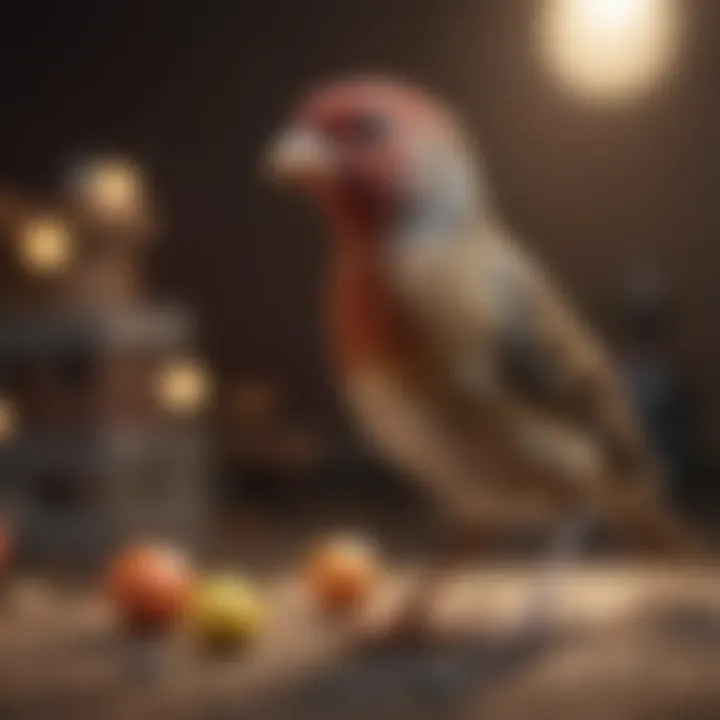
Overlooking Safety Features
When choosing toys for finches, safety should be of utmost importance. Many owners tend to overlook safety features, which can result in dangerous situations for their birds. Some toys contain small parts that can be ingested, while others may have sharp edges or toxic materials.
A responsible pet owner should carefully inspect every toy before purchase. Look for:
- Natural Materials: Toys made from untreated wood or cotton are safer than those made from plastic or synthetic fibers.
- Non-Toxic Paints and Dyes: Ensure any coloring used on the toy is non-toxic and bird-safe.
- Robust Construction: Toys should be durable enough to withstand your finch’s beak without breaking.
Birds are curious by nature, and a toy that looks appealing may not always be the safest option. Each toy should be examined for hazards before introduced into the cage. In doing this, an owner can avoid accidents that might lead to injury or vet visits.
"Safety in selection is the first line of defense for your finch's well-being."
Ignoring Individual Finch Preferences
Another frequent error is ignoring the individual preferences of finches. Just like humans, birds have unique interests and personalities. What may captivate one finch might not be appealing to another. Failing to consider these distinctions can result in toys being unused, hence wasting resources and failing to provide enrichment.
To cater to individual needs:
- Observe Behavior: Take time to watch how your finch interacts with toys. Note its preferences and dislikes.
- Variety is Key: Provide a range of toys from different categories, such as chewing, foraging, and climbing. This helps in identifying what engages your finch most.
- Adapt and Change: Regularly rotate toys. Introduce new options to keep the environment stimulating.
By keeping individual preferences in mind, bird owners can enhance their finches' quality of life significantly. Personalized enrichment leads to a happier and more engaged bird.
Expert Recommendations
In the world of finch care, understanding the role of toys goes beyond mere play. It is essential that pet bird owners seek expert recommendations to ensure they provide the best enrichment possible for their feathered companions. Expert advice can help owners navigate the myriad of options available, from types of toys to suitable materials and safety concerns. Engaging with professionals not only enhances the physical environment for these birds but also supports their overall mental and emotional well-being.
Consulting Avian Veterinarians
Consulting avian veterinarians is a crucial aspect of ensuring your finch's happiness and safety. These specialists are trained to understand avian biology and behavior, providing insights that laypersons may overlook. They can advise on the appropriate types of toys based on the specific needs of different finch species, as what works for one may not suit another.
Moreover, avian veterinarians are aware of potential health hazards linked with certain materials. For instance, some plastics can be harmful, leading to ingestion risks or toxic reactions. By working with a veterinarian, bird owners can identify safe options that promote engagement without compromising health.
Key benefits of consulting avian veterinarians include:
- Expert assessment on finch behavior and needs.
- Guidelines for safe and enriching toy options.
- Ongoing health monitoring that can inform toy selection as the bird ages.
Insights from Experienced Bird Owners
Insights from experienced bird owners offer practical knowledge that complements professional guidance. While veterinarians provide scientific understandings, seasoned pet owners share real-life experiences that are invaluable. They can highlight which toys have succeeded in captivating their finches and which have not.
Experienced bird owners often recommend considering the individual preferences of the finch. Each bird has its unique personality, and some may prefer swinging toys, while others enjoy foraging activities. Engaging with the community, such as through platforms like Reddit or dedicated Facebook groups, allows new bird owners to remix this information based on collective experiences.
Some common insights shared by experienced bird owners include:
- Observation is key: Watching how your finch interacts with various toys can guide future selections.
- Variety matters: Offering different types of toys can prevent boredom.
- Rotate toys: Keeping toys fresh by rotating them can maintain interest and engagement.
"Consult with professionals, but trust your own observations. Every finch is a little different," says a seasoned finch owner.
Seeking guidance from both avian veterinarians and experienced bird owners creates a well-rounded approach. When owners combine expert advice with practical experiences, they are more likely to create an enriching and fulfilling environment for their finches.
Future Trends in Finch Bird Toys
The future of finch bird toys is an evolving discussion that intersects with advancements in materials science, design innovation, and technology. Recognizing these trends is essential for bird owners who want to provide optimal enrichment for their feathered friends. New developments not only promise enhanced play experiences but also aim to improve the overall health and well-being of finches. Keeping an eye on these trends will be beneficial, as pet birds, like finches, thrive in environments that stimulate their natural inclinations to explore and interact.
Innovative Materials and Designs
As consumer demand grows, manufacturers are exploring innovative materials that prioritize both safety and engagement. Recent shifts have seen a move toward non-toxic, durable materials that can withstand the natural behaviors of birds, such as chewing and grasping. Bamboo and untreated natural wood are gaining popularity due to their sustainability and safety.
In addition, biodegradable materials are emerging as environmentally friendly alternatives. These innovations not only serve functional purposes but also appeal to conscientious pet owners wanting to minimize their ecological footprint.
Key points to consider when examining new materials:
- Durability: Toys made from high-quality materials can endure more rigorous playtimes.
- Safety Standards: Ensure that materials are free from harmful chemicals and sharp edges.
- Textural Variety: Different textures can enhance tactile stimulation, encouraging exploration and interaction.
Technology Integration in Pet Toys
Technology is set to revolutionize the concept of toys for finches. Smart toys, equipped with interactive features, can simulate natural behaviors in a way that traditional toys cannot. For example, some toys can incorporate motion sensors to encourage birds to engage actively. These devices can have varying levels of difficulty, adapting to the abilities of different finch species.
Furthermore, the rise of mobile applications is allowing owners to monitor their birds' activities and play habits. This data can help identify preferences and inform future toy selections. Engaging with technology offers not only entertainment for the birds but also a deeper connection between owner and pet.
Advantages of technology in bird toys include:
- Enhanced Engagement: Interactive features keep finches mentally stimulated.
- Behavior Tracking: Monitoring tools can lead to improved health and wellness insights.
- Customized Play Experiences: Toys can adapt to the unique needs of different finch species.
The future of finch toys lies in the balance between innovation, safety, and environmental consciousness. As trends evolve, it will be crucial for bird owners to stay informed and adapt to the changing landscape of avian enrichment.















